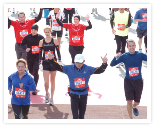












Gentle Running and Living
by Dr Patrick Salmon, PharmD, PhD
Member of the Barefoot Runners Society
Founding Member of the Tarahumara Spirit



Be gentle
to yourself
and others!
“Life is hard enough to add extra suffering to it”. We propose here a way to build a stronger, healthier and happier self through gentle running. Then, this “ascetic hedonism” can be translated into several aspects of life, to humbly contribute to a better world.

You can help your fellow humans and the world in general by sharing this site and its links.
You can join me at this email: drbarefootpat@gmail.com

Version française (en construction) à ce lien.


My blog


If you want to run a marathon in 2h or 2h30, you need to run all the way. But from 3h00 and above, you will run faster and feel better if you do the « walk-break ». When you do that, you reproduce the running pattern of our ancestors, who were pros at persistence hunting. The basics are running for 10-12 min, then walk for one minute. Then run again and so on. You do that on every training run and on every race. Your body temperature and heart rate will drop, your muscles will relax and eliminate lactic acid, you can control the refueling better and more often, etc. With this trick, you can run virtually for ever, without cramps or pain. But you need to do it from the 1st ten minutes on.
Learn or re-learn the proper way of running, either by running Barefoot or with minimalist shoes or sandals. And go to this tutorial to help you correct your running gait.
Natural Running




If you are old, or crippled, or have a heart condition, you cannot really do the true interval training as it has been developed from initial Emil Zatopek technique. What I do instead, to increase a bit my VO2max is to run fast during the last 1-2 minutes of my running period, just before the « walk-braek ». I go for this 1-2 minute period into an « uncomfortable » zone, where I really do not want to stay, but I feel safe doing it though. In a 1-hour training run, I start the 1st « red-zone » workout before the 2nd walk-break and then before every other walk-break. This means 5 workouts per session.
Interval Training for the Crippled
If you run just to stay fit, if you jog with friends or alone, between 1 and 3 hours per week, then you have the ground fitness to start this short minimalist Marathon training guide. If you run 1 hour per week or less, and you feel that you cannot increase this volume in a few weeks, then you need to go for the Marathon Training Guide for the Ungifted. No problem, that is how I started...
The 1st month
Start with 2 to 3 jogs per week. Each session is around one hour long. Run easy on uneven ground, such as trails, and find a nice lawn to do the skips. Also, in each session, remove your shoes and run easy 5 to 10 minutes barefoot on a track or a smooth road.
The goal: Build yourself strong and springy legs
The 2nd month
Now you are running 3 times a week, each session during one hour. On this ground, start to increase the length of one of these weekly sessions. This can be done preferably on week-ends. 1st WE, go out for 2 hours. 2nd WE, 2h30. 3rd WE, 3 hours. 4th WE, 3h30 or 3h45. Do not try try to run fast or faster than the previous run. Speed is irrelevant here. You just want to get familiar with long-lasting effort and also troubleshoot gear and refueling. To avoid boredom, you can do that on the beach, in the mountain, alongside rivers, etc..
The goal: Build yourself physical and mental endurance
The 3rd month
On the basis of 3 sessions per week, each during 1 hour, try to accelerate every 10 minutes for 1-2 minutes, at a speed that is uncomfortable. Then walk for 1 minute and resume jogging for 10 minutes, etc. This will increase your VO2max, with 2 consequences. 1st you will get faster. 2nd, for the same speed you will be more comfortable.
The goal: Increase your speed hence your comfort
The last week
Eat, rest and have fun




This can be fun to do and is mandatory to get stronger and have energetic and springy legs. My favourite set of drills comes from Mark Cucuzzella in this video. Of course, you can do that with shoes, especially if you do not trust what is in the grass (needles, glass, poop)
The Skips


Carbo-loading is an old belief and is useless since our glycogen stores are almost always full with our standard diet. Instead, look for diverse and healthy food. Favor fruits, unprocessed food and jjuices, veggies, chicken and cheese. Rest, walk, jog slowly if you want to run for a long time, or fast for a short time.
The Race
This is when you will merge your endurance training and your speed training. Picture the race as a one-time cosmic life event. You want to have a long-lasting memory of positive emotions, so do not hurt yourself. Split the race in 4 quarters. The 1st 10k to get started, at jogging pace. Next 10 k to enjoy your training and fitness and speed. Increase pace gradually from 10k to 20 k. Then, from 20 k to 30 k, enjoy the ride, your are beyond the half-marathon distance, a distance that almost anybody can run. This means that you are becoming a hero. Then, 30 k to finish. Walk when you want, stretch when you need, chat with people. Tell yourself you are feeling so good. If you do not feel so good, just walk a little and be nice to yourself for a few minutes. What is important is that you keep some juice for the last 5 k to fully enjoy this unique part of the marathon.
Start slowly and then pass them all !

My basic Training items
The Walk-Break


The baseline
This guide is for regular but casual joggers, 1 to 3 runs per week

“You don’t need to run a marathon to run a marathon!”
This means that you can finish your 1st Marathon with a big smile with a minimal training without the traditional 50 km long run.
